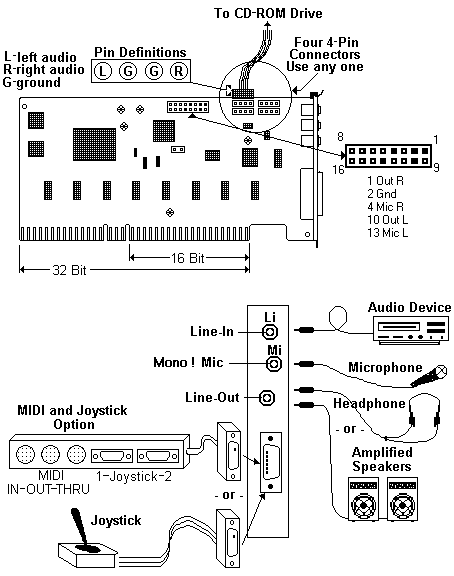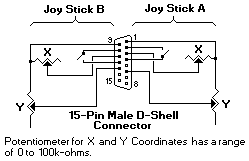Audiovation Adapter/A
Yes, I am working on it! 9 Nov 99.
 @8FD6.ADF
@8FD6.ADF
Ultimedia 16 pin connector pinout courtesy of Christian
Hansen

15-pin - Joystick-MIDI-Port Adapter
(female) Connector

15-pin - Joystick-MIDI-port Adapter Connector - Pin-layout
|
Pin
|
Signal
|
I/O
|
Pin
|
Signal
|
I/O
|
|
1
|
+5 Vdc
|
N/A
|
9
|
+5 Vdc
|
N/A
|
|
2
|
Joystick A - Button 1
|
I
|
10
|
Joystick B - Button 1
|
I
|
|
3
|
Joystick A - X-pos
|
I
|
11
|
Joystick B - X-pos
|
I
|
|
4
|
Signal GND
|
N/A
|
12
|
MIDI OUT
|
O
|
|
5
|
Signal GND
|
N/A
|
13
|
Joystick B - Y-pos
|
I
|
|
6
|
Joystick A - Y-pos
|
I
|
14
|
Joystick B - Button 2
|
I
|
|
7
|
Joystick A - Button 2
|
I
|
15
|
MIDI IN
|
I
|
|
8
|
+5 Vdc
|
N/A
|
-
|
-
|
-
|
Game Control Adapter / Joystick
Original HERE
Joy Stick Schematic Diagram

Connector Specifications (Adapter-female
side)
|
Adapter Pin No.
|
Signal
|
|
1
|
+5Vdc out
|
|
2 (SW A-port)
|
Button 4 in
|
|
3 (X A-port)
|
Position 0 in
|
|
4
|
Ground
|
|
5
|
Ground
|
|
6 (Y A-port)
|
Position 1 in
|
|
7
|
Button 5 in
|
|
8
|
+5Vdc out
|
|
9
|
+5Vdc out
|
|
10 (SW B-port)
|
Button 6 in
|
|
11 (X B-port)
|
Position 2 in
|
|
12
|
Ground
|
|
13 (Y B-port)
|
Position 3 in
|
|
14
|
Button 7 in
|
|
15
|
+5Vdc out
|
|
Option
|
FRU
|
| Audiovation Adapter/A |
13H9294 (65G8863)
|
| Joystick Option Kit |
92G7466
|
| Option |
P/N
|
| Audiovation Adapter/A |
92G7464
|
|
IBM Audiovation MIDI and Joystick Option Kit
|
92G7466
|
System Requirements (Minimum)
An IBM or compatible Micro Channel (MCA) Computer
A 386SX 25MHz or faster processor.
NOTE: Some audio applications are very demanding and may require a 486
33MHz processor)
From Christian Hansen
Audiovation works different from the ACPA. You'll need three diskettes
with drivers. They are designed for windows 3.x, but works under win95.
Whenever you install software like RealPlayer, Cooledit,
QuickTime and what have you, choose the 16bit versions, even though you
are running win95. I once tried the nice swedish game *sinksub* The 32bit
version was mute, the 16bit with crisp sound.
Sorry, these links for the av21x are dead. IBM moved things...
If you didn't get the driver disks with the card, get them from:
av211.exe
Win/DOS install disk 1 of 3
av212.exe
Win/DOS install disk 2 of 3
av213.exe
Win/DOS install disk 3 of 3
av21util.exe
Audiovation Utilities/Diagnostics
av20doca.exe
MCA Documentation (WP 5.1 format)
OS/2
avmmpm.exe
MMPM/2 support
avmwm.exe
OS/2 Audiovation Manager
avos221.exe
OS/2 Fix for release 2.1
> Just looked into the Audiovation ADF - must be the @8FD6.ADF
you'd downloaded, right? Mentioned the comments inside the file?
You could enable a PS/1 compatible Midi-port on the card with changing
one pos-byte and uncommenting some more lines further below. The funny
fact: the Midi-port sits at I/O 330h and uses Int 7 (uh-oh ... poor printer
port!)...
I don't know: Win95's "Control Panel|System"
utility doesn't show my LPT ports to utilize their "so-called" IRQ assignments.
> ...and the game-port sits at I/O 200h - which is a lot more into the
standards directions. However: I'm afraid you will get problems with the
shared Interrupt 7 under Win95, which totally dislikes IRQ-sharing.
That's because the Mickeysoft "whiz kids" who
wrote "Whenever95" were "PS/2-ignorant" and didn't even *know* there *was*
a machine which supported IRQ sharing!
Too bad they didn't walk down the hall to
the WinNT development people: as they (and any remaining Microsoft OS/2
people <g>) already *knew* of the PS/2's *superior" IRQ sharing capabilities!
> Maybe you need to reconfigure your LPT1 to IRQ5 ... Damned Win95 !!
Damned Microsoft. Why couldn't they get it right *one time*.
Game Audio Port Address, IRQ /
DMA Channel (default settings)
Port Address
= 220
Interrupt
Line (IRQ) = 7
DMA channel
= 1
Software Installation for Windows
Installing Audiovation Software for Windows
You are asked to decide which
Audiovation options you wish to install. Most users should select
the Complete Installation You may select a Custom Installation if you wish
to install a subset of the Audiovation options at this time.
(The Custom Installation will give you
the following choices: Sound Play/Record, Audio Applets, MIDI Synthesizers,
MIDI Ports, DOS Games Audio, Image Viewer.)
TalkWorks
TalkWorks provides the Audio Recorder
capability for Audiovation.
Audiovation Under W95
>>Does anyone know if Win95 drivers exist for the Audiovation sound
board?
>Nope. Sorry. Win3.1 16-bit drivers are the latest.
From Peter
... which can be used under Win95. The card even has a software-soundblaster
emulation for the DOS-mode / DOS-box which -at least- works with DOOM ...
:-)
The 16-bit software comes with own Mixer / Volume control
... the one from Win95 cannot be used and software which *requires* the
Win95 controls do not work.
One trick: do not install the Win95 Multimedia stuff or
uninstall it if you have it installed already. Then install the MWave software
and reboot the system. Make sure the MWave stuff loaded properly - then
install the Win95 Multimedia stuff again. The MWave will become "primary
audio device" after that. Then you can play WAVs, MIDs, RMI and such
... some movies do not run with sound however. Depends on.
Diagnostic Testing
There are two ways to test the Audiovation
Adapter/A. You can use the Test Your Computer on the system Reference diskette,
or you can use the atand alone diagnostic program
AUDDIAG.EXE located on the Audiovation Utilities/Options diskette.
Wrap Cable
During some of the tests you will be asked to connect
the Wrap Cable from the adapter's Line-In port to the adapter's Line-Out
port or from the adapter's Mic-In port to the adapter's Line-Out port.
The Wrap Cable is the stereo 1/8" - 1/8" audio patch/wrap cable that came
with the Audiovation Adapter/A.
It is not a special cable, and if you have misplaced it,
you can purchase a stereo 1/8" - 1/8" audio patch cable in most music or
electronic stores. If you have the MIDI and Joystick Option you are
asked to use a MIDI cable to Wrap from MIDI Out to MIDI In. (If you
have this option we assume that you have purchased MIDI cables to connect
your keyboard and you can use one of those cables as the Wrap cable.
Again it is not a special cable.)
Buzzing
I have a computer with an audio front panel that is connected
to my Audiovation Adapter using an internal cable. There is nothing
connected to Line-Out on the Audiovation rear panel. When I try to
use the Audiovation Adapter, I get a buzz from the front panel speaker(s).
Some Audiovation Adapters have an internal wrap circuit
from Line-Out to Line-In for diagnostic testing. When a 1/8 inch
phone plug is inserted into Line-Out to connect a speaker or headset the
internal wrap circuit is disconnected. But when the audio front panel
is used instead of the Audiovation rear panel, the internal wrap circuit
is not disconnected.
Try inserting the headphone set into the Line-Out socket.
If the buzz stops and the Adapter functions OK you have an internal wrap
circuit that needs to be disconnected. One solution is to purchase
a 1/8 inch phone plug and insert it into the unused Line-Out socket on
the Audiovation rear panel.
Audio
Main Page
9595 Main
Page
|

